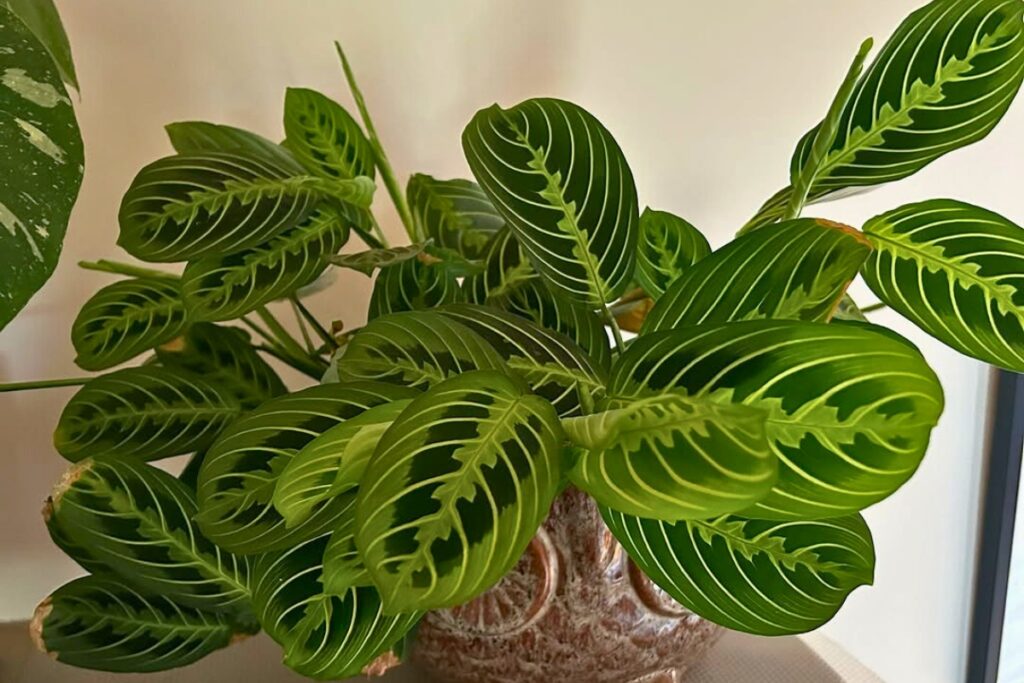If you’re a pet owner who’s eyeing that gorgeous prayer plant at the nursery, you’ll be glad to know these tropical beauties can safely share your space with furry friends. While the ASPCA confirms their non-toxic status, you’ll still need to contemplate strategic placement and protection methods to keep both plants and pets happy. The key lies in understanding how your companions might interact with these distinctive plants, and there’s more to the story than simple toxicity levels.

Contents
Understanding Prayer Plant Toxicity Levels
Prayer plants, including popular varieties like Maranta and Calathea, rank among the safest houseplants for homes with pets. You’ll find they’re classified as non-toxic by the ASPCA, meaning they won’t cause severe reactions if your cat or dog nibbles on a leaf.
While these tropical beauties won’t poison your pets, it’s still best to keep them out of reach. Your prayer plant’s leaves can cause mild stomach upset if consumed in large quantities, and you don’t want your furry friends destroying those stunning patterned leaves that move up and down throughout the day.
Common Pet Behaviors Around Prayer Plants
Ever noticed how your pets interact differently with prayer plants compared to other houseplants? Cats are particularly drawn to prayer plants’ rhythmic leaf movements, often batting at the foliage when it shifts position at dusk and dawn. Dogs typically show less interest but may investigate the rustling sounds.
You’ll notice most pets will initially approach a prayer plant cautiously, spending 30-45 seconds sniffing the leaves and soil. Many cats test the leaves’ texture with gentle paw taps, while others attempt to chew the edges. Common behaviors include circling the pot, pawing at moving leaves, and occasional attempts to dig in the soil.
Best Placement Strategies for Pet-Friendly Spaces
When creating a safe environment for both pets and plants, strategic placement becomes your most powerful tool. You’ll want to position your prayer plants at least 3 feet above floor level, using sturdy wall-mounted shelves or elevated plant stands.
Consider placing prayer plants in rooms where your pets spend less time, such as home offices or guest rooms. If you’re working with limited space, try clustering multiple plants together on a dedicated plant table that’s at least 30 inches high, with a stable base that won’t tip over.
Remember to leave enough clearance between plants for proper air circulation, typically 6-8 inches between each pot.
Protecting Your Prayer Plants From Curious Pets

While smart placement strategies form your first line of defense, additional protective measures can help safeguard your plants from playful paws and curious whiskers. Consider installing clear plastic barriers, 12-18 inches high, around your prayer plants to create a protective zone while maintaining visibility.
You’ll want to secure your plants in sturdy, weighted pots that won’t tip over easily. Place small rocks or pebbles on the soil surface to prevent digging, and consider using natural deterrent sprays containing citrus or rosemary oils around the plant’s perimeter. Apply these sprays weekly, keeping them 6 inches away from the foliage.
Signs of Plant Stress and Pet Interaction
Since prayer plants display clear signals when stressed by pet interactions, you’ll need to monitor your plants regularly for telltale warning signs. Look for curled or torn leaves, broken stems, and disturbed soil around the base – these indicate direct pet contact.
Watch for yellowing leaves, which often appear within 48 hours of damage, and check the soil moisture level twice weekly, as anxious pets may urinate near plants. You’ll notice drooping leaves pointing downward instead of their usual evening prayer position if they’re stressed.
Document any changes in leaf patterns or plant posture, especially after introducing new pets or rearranging furniture near your prayer plants.
